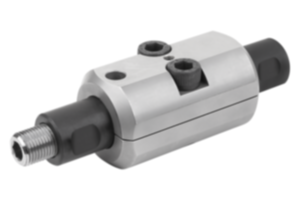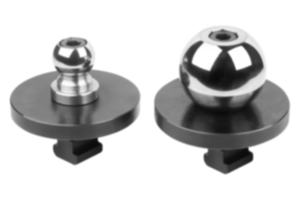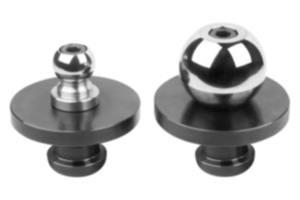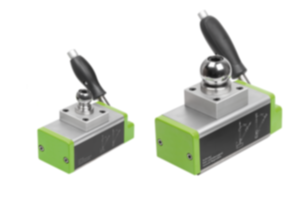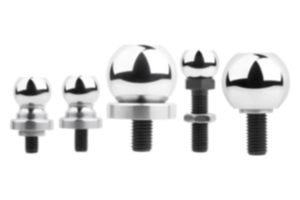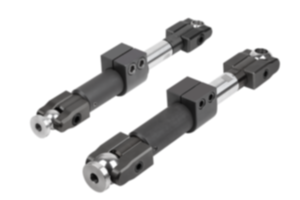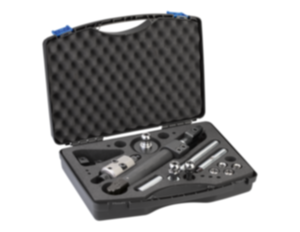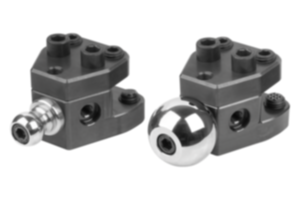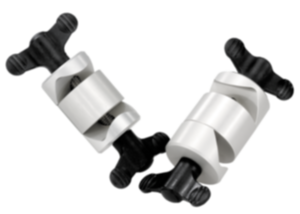Threaded Inserts
Threaded inserts by KIPP
Threaded inserts are inserted into the material of a workpiece to create a thread for screws or bolts. They are also used as thread repair inserts to repair or replace damaged threads. These inserts are used when regular threats in soft materials will not provide sufficient hold or when threads are damaged and need to be repaired. Threaded inserts improve durability and strength of threads in soft or brittle materials in different industrial applications.
There are various types of threaded inserts, but they are generally made of stainless steel or steel. Threaded inserts are inserted into a previously drilled and tapped hole. Once inserted, the threaded insert provides a strong and reliable threadfor securely fastening screws or boltholes
is why threaded inserts can be found in a wide variety of applications, such as in plastics processing, metalworking or carpentry. Above all, threaded inserts are used in the electronics industry to reinforce threads in housings or other components.
Key features of threaded inserts:
- Threaded inserts are usually made of metal to ensure strength and corrosion resistance.
- Standard threaded inserts are screwed into previously drilled and tapped holes. There are different techniques to install threaded inserts.
- Also available are self-locking threaded inserts. These prevent unintentional loosening of the inserted parts.
- Threaded inserts are versatile and can be used in a variety of materials, such as metal, plastic, wood and many more.
Different types of threaded inserts
The importance of threaded inserts
Application areas for threaded inserts
Treatment of over-tightened threads
What to do if a thread does not engage?
The role of threaded inserts by KIPP
Different types of threaded inserts
When manufacturing the different threaded inserts KIPP pays particular attention to the use of high-quality materials. Threaded inserts by KIPP are made from steel or stainless steel. While stainless steel inserts are heat and corrosion resistant, steel ones are the less expensive option.
As a manufacturer, KIPP touches ground with a wide range of industrial companies. This simplifies the production of operating parts, because we know exactly what is important. Our experience enables us to offer you a wide range of inserts. These include standard inserts and also self-tapping, self-locking and solid body threaded inserts.
Every threaded insert has two threads:
- The external thread is for screwing the threaded insert into the pre-tapped hole in the workpiece.
- The internal thread sports the size appropriate for the thread being fitted. This allows for the fastening of a screw, bolt or other element with a suitable external thread.
Threaded inserts by KIPP are available with the following internal thread sizes:
M3, M4, M5, M6, M8, M8x1, M10, M10x1,25, M12, M12x1.25, M14, M14x1.5, M16, M16x1.5, M18x1.5, M20, M20x1.5, M22x1.5, M24, M24x2
Standard threaded inserts are inserted into pre-drilled and tapped holes. Threaded inserts with the following external threads are available:
M8, M10x1.25, M12x1.25, M14x1.5, M16x1.5, M18x1.5, M20x1.5, M22x1.5, M24x1.5, M30x2, M32x2, M33x2,
Threaded inserts by KIPP allow for the repair of damaged, stripped or seized tapped holes. They therefore make it possible to repair and recover high-quality products. Threaded inserts are very versatile and are suitable for use in light metals and castings. Installation is simple and quick.
In addition to reinforced threaded inserts and standard versions, KIPP also offers self-tapping threaded inserts.
Self-tapping threaded inserts are used to create heavy-duty, wear and vibration resistant screw connections in materials with a low shear strength. These materials can be aluminium, aluminium alloys, brass, bronze, cast iron, thermosets and thermoplastics to name but a few.
Self-tapping threaded inserts are tapered at one end and have a cutting slot or cutting bore. These threaded inserts cut their own thread as they are screwed into a pre-drilled hole. This leads to a reliable and fixed anchoring in the workpiece material.
In some materials, the threaded insert with cutting slot slightly bounces inwards in the vicinity of the slot. This creates a screw locking effect. If this effect is not desired, we recommend using the threaded inserts with cutting bore.
Threaded inserts with cutting bore are particularly suitable for materials that are difficult to machine. The thicker wall permits more force to be absorbed and then distributed over three cutting bores.
In addition to individual threaded inserts, KIPP offers the following installation accessories:
- Assembly tools for threaded inserts: available with five different internal thread sizes.
- Repair sets: allow for the repair of damaged, torn or seized tapped holes.
- Installation tools for self-locking threaded inserts: are available as manual or machine operated tools. Manual tools may be operated using a cordless drill. Machine operated tools are used in tapping machines or drilling machines.
The importance of threaded inserts
Threaded inserts are advantageous in a wide variety of applications. The biggest advantage is that they allow for the repair of damaged or stripped tapped holes. This means that valuable components can be saved and reused. As a result, the operating parts also contribute to the recovery of rejects .
Increased durability also is one of the major advantages of threaded inserts. The use of threaded inserts improves durability of threads in soft or brittle materials that would not be sufficiently strong on their own. In addition, thread inserts prevent thread loss in soft materials. In addition to stability, threaded inserts offer increased vibration resistance. This advantage is particularly important in applications with strong vibrations or shocks to prevent the connection from loosening.
In addition to their suitability for use in various materials, cost efficiency and ease of installation round off the profile of threaded inserts.
Application areas for threaded inserts
Threaded inserts are used in a wide range of applications where reliable, strong and durable threaded connections are required.
Threaded inserts are often used to repair damaged, stripped or worn threads. This often occurs in machines, vehicles and other mechanical components.
The operating parts are also used in light metal or plastic materials. As light metals such as aluminium or plastics do not normally have the required strength for threads, threaded inserts can help to create strong threaded connections.
Threaded inserts are also used in the following sectors:
- Automotive industry: Especially in connecting elements, such as cylinder head bolts, oil sumps, gearbox housings, and other critical components.
- Aviation industry: Due to their low weight and ability to be used in different materials, threaded inserts are used in components such as aircraft structures, engines and landing equipment.
- Construction industry: In the construction industry, threaded inserts can be used in structures, mountings and other building applications to ensure a stable connection in different materials.
Threaded inserts are also used in the electrical industry, medical technology and toolmaking. The versatility of these inserts permits their use in a wide range of industries and applications.
Treatment of over-tightened threads
Over-tightened threads occur when a screw or bolt has been screwed into a tapped hole beyond the permitted torque. This leads to thread damage.
Here are our tips for treating an over-tightened thread!
First, check the degree of damage. Sometimes the thread may only be slightly over-tightened, while in other cases it may be severely damaged.
A simple solution to the problem may be to use a larger screw that fits into the over-tightened tapped hole. Spacers or a washer can also be used to compensate for any additional space in the over-tightened tapped hole.
To create a new intact thread, thread repair inserts can also be used. Using inserts to repair over-tightened tapped holes can be an effective solution.
It is important to note that the method chosen depends on the type of application, the type of material and the degree of damage. In some cases, it may be necessary to repair the damaged tapped hole before a screw or bolt can be safely inserted.
What to do if a thread does not engage?
If the thread does not engage properly, this may be due to a variety of reasons, including over-tightening, damage to the thread or insufficient strength. The solution to this problem is the same as for the treatment of over-tightened threads.
You could use a larger screw or a threaded insert. However, if the thread is damaged or the material has insufficient strength, it is best to use a threaded insert:
- Carefully inspect the tapped hole for damage, over-tightening or contamination. Clean the tapped hole thoroughly to ensure that it is free of residue.
- Select a threaded insert that matches the size and thread type of the tapped hole. The accuracy of fit is crucial for a successful repair.
- Carefully drill out the damaged tapped hole to the size required for the external thread of the threaded insert. Pay particular attention to selecting the correct diameter and depth. Tap a thread into the hole.
- Insert the threaded insert into the prepared hole. If necessary, you can use tools or a suitable adapter.
- Now insert the screw or bolt into the threaded insert. Ensure that the screw connection is correct and tight.
- Avoid over-tightening the screw or bolt to prevent it from being damaged again. The torque recommended by the manufacturer should be observed!
Careful application of these tips and steps should help you to create a stable connection between the elements.
The role of threaded inserts by KIPP
KIPP stands for quality and reliability! Buying KIPP threaded inserts is an investment in quality, durability and user-friendliness. We know what is important in the production of threaded inserts. Strict quality standards ensure you only get the best! Besides the advantages of threaded inserts, which have already been described above, ordering from KIPP means reliable delivery.










